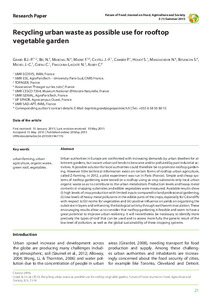| dc.date.accessioned | 2015-05-27T07:49:01Z | |
| dc.date.available | 2015-05-27T07:49:01Z | |
| dc.date.issued | 2015-05-20 | |
| dc.identifier.issn | 2197-411X | |
| dc.identifier.uri | urn:nbn:de:hebis:34-2015031947776 | |
| dc.identifier.uri | http://hdl.handle.net/123456789/2015031947776 | |
| dc.language.iso | eng | |
| dc.publisher | Department of Organic Food Quality and Food Culture at the University of Kassel, Germany and Federation of German Scientists (VDW) | eng |
| dc.rights | Urheberrechtlich geschützt | |
| dc.rights.uri | https://rightsstatements.org/page/InC/1.0/ | |
| dc.subject | urban farming | eng |
| dc.subject | urban agriculture | eng |
| dc.subject | organic waste | eng |
| dc.subject | green roof | eng |
| dc.subject | vegetables | eng |
| dc.subject.ddc | 630 | |
| dc.title | Recycling urban waste as possible use for rooftop vegetable garden | eng |
| dc.type | Aufsatz | |
| dcterms.abstract | Urban authorities in Europe are confronted with increasing demands by urban dwellers for allotment gardens, but vacant urban soil tends to be scarce and/or polluted by past industrial activities. A possible solution for local authorities could therefore be to promote rooftop gardening. However little technical information exists on certain forms of rooftop urban agriculture, called Z-Farming. In 2012, a pilot experiment was run in Paris (France). Simple and cheap systems of rooftop gardening were tested on a rooftop using as crop substrates only local urban organic waste so as to contribute to the urban metabolism. Production levels and heavy metal contents in cropping substrates and edible vegetables were measured. Available results show (i) high levels of crop production with limited inputs compared to land professional gardening, (ii) low levels of heavy metal pollutants in the edible parts of the crops, especially for Cd and Pb with respect to EU norms for vegetables and (iii) positive influence on yields on organizing the substrate in layers and enhancing the biological activity through earthworm inoculation. These encouraging results allow us to consider that rooftop gardening is feasible and seem to have a great potential to improve urban resiliency. It will nevertheless be necessary to identify more precisely the types of roof that can be used and to assess more fully the generic result of the low level of pollution, as well as the global sustainability of these cropping systems. | eng |
| dcterms.accessRights | open access | |
| dcterms.bibliographicCitation | In: Future of Food: Journal on Food, Agriculture and Society. Witzenhausen : University of Kassel, Department of Organic Food Quality and Food Culture. - Vol. 3, No. 1 (2015), S. 21-34 | |
| dcterms.creator | Grard, Baptiste Jean-Paul | |
| dcterms.creator | Bel, Nicolas | |
| dcterms.creator | Marchal, Nicolas | |
| dcterms.creator | Madre, Frederic | |
| dcterms.creator | Castell, Jean-François | |
| dcterms.creator | Cambier, Philippe | |
| dcterms.creator | Houot, Sabine | |
| dcterms.creator | Manouchehri, Nastaran | |
| dcterms.creator | Besancon, Stephane | |
| dcterms.creator | Michel, Jean-Charles | |
| dcterms.creator | Chenu, Claire | |
| dcterms.creator | Frascaria-Lacoste, Nathalie | |
| dcterms.creator | Aubry, Christine | |

